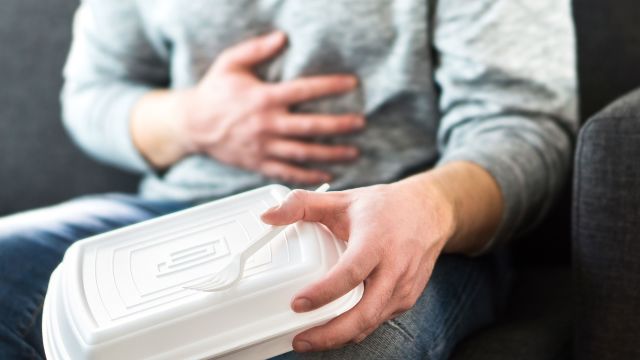Hawaii is ranked as the healthiest state in the country, according to America’s Health Rankings by the United Health Foundation, where Kamaaina can experience great air quality and less stress. Yet our state falls short when it comes to salmonella infections. We have one of the highest numbers of reported salmonella cases each year, with about 21 incidents per 100,000 people, compared to almost 17 per 100,000 nationally.
Salmonella, or salmonellosis, is a bacterial infection that sets up shop in your gut and can wreak havoc on your intestinal tract. Named after Daniel Salmon, DVM, a veterinarian whose work in the late 1800s helped lead to its discovery, salmonella is responsible for more than 1 million infections, 23,000 hospitalizations and some 450 deaths in the US every year.
There are more than 2,500 strains of salmonella, but only around 100 cause human infections. The two most common types of salmonella in the United States are Typhimurium and Enteritidis. In less industrialized parts of the world, such as Africa, Asia, Eastern Europe and Latin America, a dangerous strain called Salmonella Typhi is more common and causes typhoid fever.
How do you get salmonella?
Salmonella infections are highly transmittable diseases. Typically contracted via fecal-oral transmission, it plagues the intestines of many animal species and is shed through their feces. You ingest it by eating food or drinking water contaminated by the bacteria.
Food is the primary source of infection. The most common culprits are chicken, beef, eggs and unpasteurized dairy products. However, anything from fresh fruits to processed foods, such as peanut butter, can come into contact with the bacteria. Transmission occurs either when you directly consume meat from an infected animal, or their by-products like eggs or unpasteurized milk. It can be transmitted from a person carrying salmonella who prepares your food without properly washing their hands or from environmental contamination such as plants grown from contaminated seeds or exposed to contaminated fertilizers or water.
Reptile-transmitted infections are another type of common salmonella source in Hawaii. Turtles, lizards and amphibians harbor the bacteria on their skin. Reptiles in your home can spread salmonella through their feces as well, meaning anything they touch can become infectious. This may also be true for common house geckos in Hawaii.
“And kids, especially boys, like reptiles a lot and they handle them, but they’re not really great about washing their hands,” says Sarah Park, MD, the head of the Disease Outbreak Control Division for the State of Hawaii. The Centers for Disease Control and Prevention recommends washing hands for at least 20 seconds with soap and warm water after handling reptiles, including geckos. Also wash any surfaces in your homes where reptiles may have been present, including their aquarium.
Why are salmonella infection rates higher in Hawaii?
It’s unclear why Hawaii has higher rates of salmonella, but a possible reason is due to the state’s year-round warm weather, creating ideal conditions for bacteria to multiply and thrive. Moreover, since the culture revolves around food and celebration, pot lucks are commonplace, which means dishes are left under the hot sun for extended periods of time and become a rapid breeding ground for bacteria. What your body might have fended off without any symptoms when the food was first served may cause a problem after several hours of bacterial growth.
Anyone is at risk, but most people have common, run-of-the-mill infections. Severe infections occur more frequently in infants, young children, pregnant women, kupuna and people with compromised immune systems.
Signs and symptoms
Diarrhea, stomach cramps, nausea and fever are among the symptoms that appear about 12 to 72 hours after infection. Recovery typically takes place without intervention within four to seven days. Those who are more vulnerable can develop severe symptoms, including dehydration that requires intravenous fluids.
In serious cases, salmonella can spread to other areas of the body. If the infection spreads to the bloodstream, any organ can become infected, such as the liver, gallbladder, bones or meninges. Additionally, a minor number of people can develop joint pain and reactive arthritis that’s specifically triggered by an infection.
If you suspect a salmonella infection and have symptoms like dehydration, blood in your stool, high fever, inability to drink fluids due to nausea or vomiting, diarrhea lasting five days or severe abdominal pain, contact your doctor. It’s always a good idea to consult a doctor if you’re experiencing any kind of prolonged discomfort. Check with your doctor before taking any over-the-counter medications as some anti-diarrheal medicines may actually prolong diarrhea caused by salmonella.
How is salmonella diagnosed?
A stool sample is required to diagnose salmonella. Since people are often reluctant or embarrassed to provide a sample, Park estimates that for every case of salmonella reported in Hawaii, there are at least 10 or more unreported. Providing a stool sample is helpful, however, not only to confirm a diagnosis but to find the source.
“If we get a bunch of signals all clustered around the same time and place, it helps us see a potential outbreak forming,” says Park. “It can help us identify what the source may be and identify it quickly and then control further spread by removing it.”
When Hawaii Department of Health officials find three “positives” of the same strain of bacteria from three individuals at a similar location around the same time, they search for a source. Investigations determine whether contamination was the result of poor sanitation practices in a restaurant, for example, and ensure that proper protocols are taken to stop further transmission.
Salmonella treatment
Most healthy individuals can ride out symptoms and recover without medicinal aide. Dehydration is always a risk with an infection that causes vomiting and diarrhea. Make sure you restore electrolytes and drink plenty of fluids.
Treatment with antibiotics is usually only recommended for people with a severe infection, such as one that has entered the bloodstream, or for people who are considered high risk of developing complications, such as seniors, infants or people with a weakened immune system. Antibiotics don’t alleviate symptoms and will cause you to shed the bacteria in your stool for an extended period of time, making you more likely to contaminate others or potentially relapse.
If the infection becomes severe, see your doctor. In some cases, hospitalization might be required and treatments prescribed.
How to avoid salmonella infection
There are several ways to avoid a salmonella infection and ways to prevent it from spreading:
- Wash hands thoroughly for at least 20 seconds with soap and warm water, especially after using the bathroom, handling pets, changing diapers and before preparing food.
- Cook meat thoroughly: poultry to at least 165 degrees Fahrenheit, ground meat to 160, pork and steaks to 145.
- Keep pets healthy and their habitats clean. The healthier the pet, the less likely they will carry salmonella. Reptiles might be considered “low maintenance,” but they require as much care and responsibility as any other pet.
- Don’t drink untreated water.
- Wash cutting boards, utensils and countertops with hot, soapy water after food contact. Consider keeping separate cutting boards specifically for meat.
- Don’t drink unpasteurized milk or eat undercooked meat or raw eggs.
- Keep food refrigerated after purchase, including eggs from a farmer’s market.
- Thoroughly wash all fresh produce before use.
- Separate cooked foods from raw foods.
- Chill foods directly after serving them.
Remember that you can transmit the bacteria while you’re infected. If you work in the food industry or are a healthcare worker, it may be best to stay home until you regain health.
“Just be mindful because no one wants to get sick,” says Park. “Salmonella is not something you want.”






